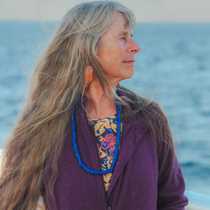Riga, Latvia
Our Expedition Leader made an early wakeup call this morning, as the sun began its slow march from the eastern sky, lighting both the old and new buildings of downtown Riga. During the next hour, the sky turned from light pink to a deep pinkish orange as the sun prepared to greet the day on another port city of the Baltic Sea.
The National Geographic Explorer was preparing to tie up near the Vansu Bridge, very close to the center and old town of this capital city of Latvia. Once breakfast was finished, we began an early tour of this well-known Hanseatic trade city. We traveled by bus to our first stop in Riga in the heart of the Art Nouveau district.
Stepping out of the bus, and back one hundred years, we had an opportunity to wander briefly along several streets taking a moment to look up into the fairy tale world that can often make up Art Nouveau architecture. This movement peaked in popularity between the late 1800’s and the early 1900’s and represented an explosion in design and creativity. The idea was to be as broad as possible in a very holistic way, encompassing all facets of one’s life.
It was possible to live in an art Nouveau-inspired house with Art Nouveau furniture, silverware, crockery, jewelry and clothing! The Art Nouveau movement wanted to make art part of everyday life, in essence to break down the barriers between the fine arts and applied arts. Many historians view Art Nouveau as an important bridge between the historicism of Neoclassicism and Modernism. The movement started in Scotland and moved throughout Europe, and our visit today is one of the European treasures of preserved and restored Art Nouveau buildings.
Riga, Latvia represents an enormous number of buildings, many of which are recognized by UNESCO as significant contributions to cultural heritage. After the remainder of our brief bus tour, we gathered near the freedom monument and began our city tours of old town. A stop was made at the small Guild House to enjoy a Latvian folkloric performance by the Dzitarins. The name of this children’s dance group is the Latvian word for amber and a word commonly seen and used throughout Latvia.
After this delightful experience we continued on our walking tour throughout the narrow streets of Riga. Because of its protected position in the Bay of Riga, this Baltic city enjoyed tremendous prosperity trading between eastern and central Europe during the 13th and 15th centuries.
Our walking tour took us into the medieval center of the Riga, finishing at St. Mary’s or the Dome Cathedral. From our central seats we listened as the world’s largest organ filled the Cathedral with music. All too soon, the doors of this magnificent church were opened, our private concert over, and we had a just enough free time to explore some of the streets and shops of old town Riga.
One of the most famous items to take some time admiring is dzintarin, or amber, and many of us enjoyed the opportunity to admire the interesting Latvian craftsmanship in setting this famous Baltic semi precious gem.
The last shuttle left central Riga at 1:30pm and began the quick journey back to the NG Explorer. Once everyone was on board enjoying lunch, our ship pulled quietly away from the pier and began her journey back down the Daugava River heading for the Baltic Sea.
Our Natural History staff adjourned to the outer decks for interpretation as we made our way out towards the sea through the port of Riga. We entered the Gulf of Riga, remaining in somewhat protected waters before entering into the windswept waters of the Baltic.
Ahead of us lay the next country on our list to visit. There will be another new culture, along with new faces, new foods and more complex history to digest as we reflect on the paradoxes and contradictions that make up an extraordinarily diverse and interesting set of countries bordering on the Baltic Sea.




